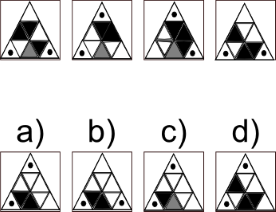At GradTests we have heaps of tips and tricks to help you smash your next inductive reasoning test. Remember, the best way to improve your inductive reasoning test is practice.
Learn the most common patterns
There are a set of extremely common patterns that the test providers will re-use. It’s therefore essential to practice as many inductive reasoning tests as possible to learn these patterns until they are second nature to you. These patterns include such things as rotation, mirroring, flipping, replacement, swapping, numbers of side/shapes changing (division, multiplication, addition, subtraction), trends (constant, increasing, decreasing), axes of symmetry, degrees/angles, layers of shapes etc. These terms probably mean nothing to you right now but don’t worry, practice makes perfect. Get started on learning these patterns by taking free inductive reasoning test right now.
Use the elimination method
The optimal method of solving these logical problems is to use what we call the elimination method. Basically the elimination method is rule out one answer option at a time, until there is only one left, and so it must be the correct answer by deduction. We’ll see an example of this below.
Lock onto one sub pattern at a time and follow that through
Within any logical reasoning question, there will normally be numerous objects that have their own distinct patterns. You should focus on figuring out the pattern of one object at a time, following it through to the end and eliminating any answer options that don’t fit. This is most easily demonstrable with an example. You need to pick which comes next in the sequence – you have 4 options in this case.
It’s wise to lock your eye on to one object at a time and figure its pattern out. To that end, let’s start with the black dots. The pattern for those is that they are moving around the three points of the triangle in an anticlockwise direction. They are moving one place each at a time. In the next step, therefore, the dots must be in the top and left corners of the triangle. Using the elimination method, you can therefore eliminate option b).
Next, let’s look at the grey triangle. It looks like it stays in the same position, albeit in the 4th square it’s obscured by the black triangle. That unfortunately doesn’t help eliminate any answer options – that’s just bad luck.
Finally, there are three black triangles; a group of two and a single one. The two black triangles each rotate clockwise by one position (60°) each step, while the single black segment rotates anticlockwise by 60° each step. If you follow that pattern through, it’s clear that the correct answer, therefore, must be a). Don’t be confused by only seeing two black triangles in this option – it’s because two of the triangles are in the same position, so they obscure one another. This is a common trick employed by the test providers, so watch out for that one.

Don’t forgot what you’ve eliminated
Solving some of these logical problems is quite mentally taxing. It’s especially so under the duress of test conditions, where you are battling the clock, and also have such a big deal riding on your performance. Because of this it’s actually easy to forgot which options you’ve eliminated by the time you get to figuring out the final pattern. So you need to avoid this somehow. There’s a few options. You could jot down on some paper which ones you’ve eliminated. That might be too time consuming however. The other option is to just hold your fingers on your screen over the options that you have eliminated.






